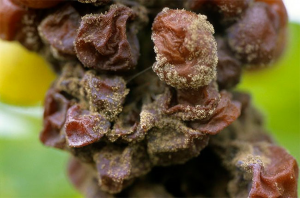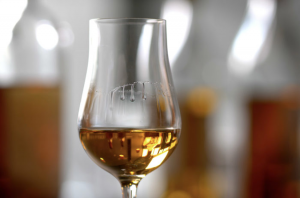Back in the day, there was a pop song called, “Kisses Sweeter than Wine”. That singer wasn’t talking about an ultra-brut Champagne or a Chianti. Today, most people who enjoy wine tasting are sipping table wines, not dessert wines. Sweet wines have been around since Biblical times, but they aren’t the focus of winemaking in most parts of Wine Country.
Sauternes grapes, shriveled with botrytis. Photo courtesy of Decanter.com.
Now there are some great sweet wines available. The best known are from Sauternes in France and Portugal, with Château d’Yquem the best known in the former and a lot of great producers of the latter. There is Passito from Sicily, or more properly from the tiny island of Pantelleria near Sicily. In Valpolicella you can find Recioto, which is Amarone for which they stop fermentation while much of the sugars remain. The Australians make some great ones and call them “stickies”. And many Canadian and American wineries make fine dessert wines as well. But with some notable exceptions, these sweet wines are the encore, not the main show.
Photo courtesy of Wine Enthusiast.
If you’re in most of Wine Country and you want to find out what the wineries have to offer for after-dinner sipping, there are some things you ought to do.
- Find out if they have dessert wines. Few wineries list dessert wines on their tasting lists, but many have some below the bar. When you’ve finished your allotted tastes, there’s nothing wrong with asking, “Do you make a sweet wine”. Note that we don’t recommend asking if they have any available for tasting. Many wineries only make dessert wines when conditions (weather, size of the crop, spread of a fungus) permit. So they may make some but not have it for tasting. By asking as we suggest, you stay on the right side of politeness.
- Know what you’re tasting. Too many California wineries make what they call a Port, but really they’re just red dessert wines, never approaching what you can find in Portugal. Whites include late harvest, ice wines (and fakes made by putting grapes in the freezer) and wines made from grapes affected by botrytis, a fungus also known as the Noble Rot. These are listed in order of rarity and cost. They each have their own character, some but not all of which is apparent at a wine tasting. The best ones change in color, sweetness, density and concentration as they age. What you’re going to get in a tasting room are young wines, which may very well be your preference. But remember that the ages of Ports and Madeiras are measured in decades.
- Sip s-l-o-w-l-y. If a winery has a dessert wine available for tasting, you’re likely to get one or two thimblefuls, served in a tiny glass. Take a small sip and let it spread in your mouth. Think about the flavors: honey, peach, pear, citrus, honeysuckle and other delights. Then, once your mouth has been primed, try another sip. It may not seem the same, because you’ve passed the shock of the sugars on your tongue. This is when the real character of a dessert wine becomes apparent.
Dessert wines are made from shriveled grapes, in which the juice is extremely concentrated. Naturally, you don’t get a lot of wine from a bunch of scrawny grapes and that’s what makes dessert wines so expensive. They are often sold in half-bottles, so maybe allow yourself a luxury purchase after you’ve tasted some that you liked.

